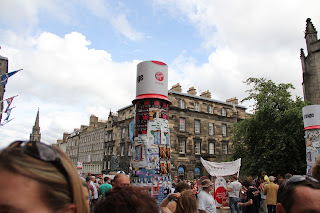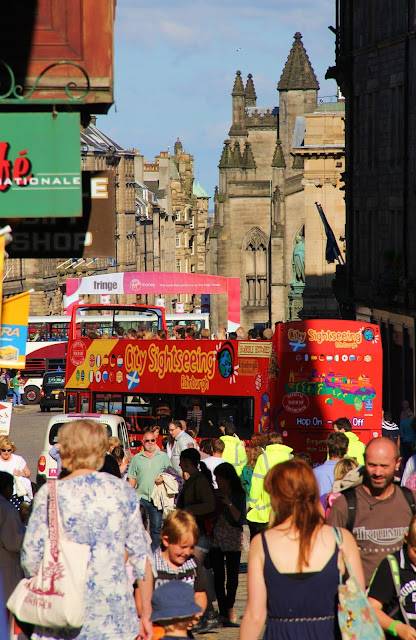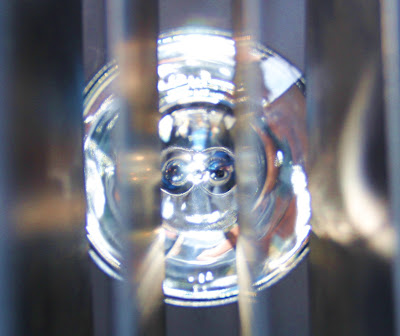Beinn Dearg (Atholl) is a large lump of a hill which is the SouthWestern corner of the four Munro's collectively known as "The Ring of Tarf". It gets it's name (which means Red Hill), from the pinkish tint in the granite from which its' hard upper reaches are made. Beinn Dearg is not an especially dramatic mountain in shape and throws up no awkward obstacles or demanding climbs to test the walker who wishes to make its bald summit. Climbing this hill still presents something of a challenge though - simply by virtue of its distance from any public road.
We left the car at Calvine, where the landrover track which leads up to the Minigaig Pass begins, and which is used by the Atholl Estates as an access road to their busy hunting lodge in Glen Bruar, known as Bruar Lodge. Other routes in, such as that from Old Blair are reputedly prettier, but needing to cover the eight or nine miles to the foot of the hill within the time-limits imposed by family commitments, we opted to cycle the Bruar Lodge track all the way to the hill.
The track gets off to a brutally steep climb, ascending rapidly on the stony track as it winds its way Northwards, away from the noise of the A9. The constant ascent is broken by one major descent as the track crosses the minor hills of Colrig (446m) and Creag Bhagailteach (492m) before dropping a hundred metres of so to the side of Bruar Water. While this descent is a blessed relief to burning muscles and knees on the way in - it was a cautionary note that the way home would not all be freewheeling later in the day!
Bruar Lodge is an impressive sight, a large, active hunting lodge, nestling high in a remote glen, it is the centre of a little community of houses which gather round it. As we cycled up to the lodge, it became apparent that there was a shoot on. Unfortunately, because our delayed start to the day we had missed the party leaving for the the hills. By the time we had thought to use the HILLPHONES service, we were out of telephone range, and so called at one of the houses to ask about a route which wouldn't interfere with the hunters. I have heard many tales of friction between walkers and estate ghillies - but personally I have never had any problems, wandering up, having a chat and asking where I can walk without getting in their way. The advice from the folks around the lodge was to head on past the normal ascent routes which lie to the south of the summit, and take the pony track up between Beinn Dearg and Beinn Losgarnaich to ascend the final section of Beinn Dearg from the west. This was a significant diversion - but one we were happy to make in order to both allow the shooting party to enjoy their day out, and minimise the chances of spending the night in hospital having lead shot removed from our bodies!
This turned out to be a very straightforward line of approach to the hill. Leaving the main landrover track at a bridge just under a kilometre north of the lodge, a good track soon emerged on the north bank of the burn. This we followed until it petered out just after the 700m contour. The 1:25,000 scale OS map shows this path continuing, but it wasn't obvious where it went. With the top in sight from here we turned westwards across the bogs and peat hags (easily navigable despite the recent heavy rain), and clambered up the boulderfield to the broad summit which is crowned by a large circular cairn built around an old trig-point.
The Tarf and Tilt hills, as they are known, are a wide area of heathclad moors, and rolling uplands - named after the two major rivers which export their rainfall southwards into the River Tay.
The Tarf is hardly breathtakingly spectacular in the way that The Cuillin in Skye arrest the attention. Yet these vast expanses of uninhabited Perthshire have a majesty and beauty of their own - which simply cannot be appreciated through a car windscreen at 70mph on the A9. These are hills which need to be walked, and which need to be climbed; they have vast horizons which need to be gazed at for long periods of time, from the highest of their view-points. As the photos show, the light was poor; clouds billowing through with occasional drizzle - with alternative columns of shade and sunshine chasing each other in successive waves over the undulating heather below. Sitting up there (even in August!) was a chilling experience - and feeling the cold pinching us we decided to make a move - retracing our steps to the bikes we had left at the foot of the Alt Beinn Losgarnaich.
The outward cycle is mostly downhill, and the miles just race by. The one climb, past Colrig, was hard, and at the end of a long day, extremely challenging. The reward of this effort though is a spectacular downhill run, at break-neck speed all the way back to the car. The mapping software tells me that we covered 22miles, 17 of which were on the bikes, enough distance and effort to make this hill feel like a achievement, not just a nice day out.


















































